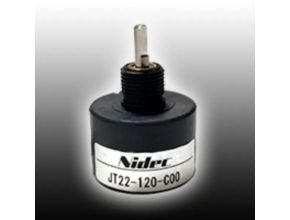Nidec Copal JT22 Single-turn Optical Contactless Potentiometer Potentiometers are displacement sensors that produce electrical output (voltage) in proportion to the mechanical displacement. They are basically composed of a resistor and a wiper (brush), with the mechanical displacement of the resistor relative to the wiper being accurately converted into an electrical voltage output. A voltage is applied to both ends of the resistor, and the wiper is moved. The displacement is measured by the voltage between one terminal of the resistor and the wiper. Looking at the component structurally, we can see the following: (Fig. 1) Further, the following formulas apply to the voltage output

Model of potentiometer
Wirewound Type
Precision wire winding technology has been used to achieve low noise and long life. Wirewound types include the single-turn J series for use in servo drives and the multiturn M series for use in settings.
Conductive Plastic Type
Special film resistors and original contact construction provide long life, with degradation that is theoretically infinitely small. Conductive plastic types include single-turn types and linear types, both for use in servo drives.
Cement Type
The use of cermet resistors allows for low prices. The degradation is theoretically infinitely small. Cermet types are single-turn for use in servo drives and for settings.
Optical Contactless Type
Contactless configuration offers a much longer life and lower noise compared with the conventional contact method.
Optical Contactless Principle
Optical contactless potentiometers shall detect the rotational angle at the time of shaft rotation by positioning sensor which photo-electrically transfers the displacement of light transmitted through a spiral slit that is placed between the luminous element and the positioning sensor
Features
- Contactless configuration offers much longer life
- Low torque 0.147 mN·m {1.5 gf·cm} maximum
- Superior temperature characteristic due to temperature compensation circut incorporated
- Wide effective electrical angle (120° • 320°)
- RoHS compliant
Applications
Nidec Copal Electronics’?products are widely used in various applications, mainly in industry.
- Vehicle,?Construction machine
- Medical equipment
- Analytical?/?Messuring equipment
- FA equipment
- Residential facility,?Security
- Social?infrastructure,?Commercial?tool,?etc.
Specifications
Electrical characteristics
| Input voltage | 5 ± 0.25 VDC | 12 ± 0.6 VDC | ||
| Dissipation | 40 mA maximum | |||
| Effective electrical angle | 120° | 320° | 120° | 320° |
| Output voltage | +0.5 ~ +4.5 V | |||
| Absolute linearity??1 | ± 3.0 % | |||
| Temperature sensitivity | ± 3.0 %FS (± 2.0 %FS/-30~70 °C) | |||
| Temperature medium drift | ± 40 mV | |||
| Insulation resistance | 100 M? (at 500 VDC) minimum | |||
| Dielectric strength | 500 VAC (1 min) | |||
? ??At normal temp.
Mechanical characteristics
| Starting torque | 0.147 mN·m {1.5 gf·cm} maximum?at normal temp.? |
| Maximum rotational speed | 1500 min-1 |
| Mechanical angle | 360° continuous |
| Rotational life | 1 X 108 revolution?at 25 °C, 200 min-1? |
| Vibration | 147 m/s2 {15 G} 30 ~ 200 Hz, 30 h |
| Shock | 294.2 m/s2 {30 G} minimum |
| Strength of tighten screw | 0.49 N·m {5 kgf·cm} maximum |
Environmental characteristics
| Operating temp. range | ? 30 ~ 80 °C |
| Storage temp. range | ? 30 ~ 85 °C |
| Humidity | Relative humidity 95 % maximum |
| Net weight | Approx. 12g |
| Protection grade | IP40 |
For More Information and Price : Nidec Copal JT22 Single-turn Optical Contactless Potentiometer
Read More Article :
- Asiantool A1H65PS Non-Mercury Slip Ring
- Asiantool A1H90PS Single Conductor
- Asiantool A1H65S Single Conductor
- Mitsubishi Electric 7011B Single Phase Ups
- Nanaboshi NCS-5025-P Circular Connector





